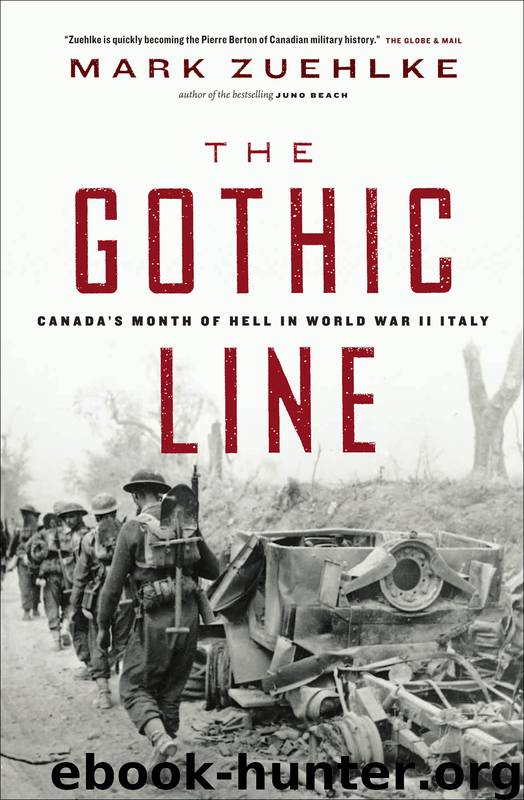The Gothic Line by Mark Zuehlke

Author:Mark Zuehlke [Zuehlke, Mark]
Language: eng
Format: epub
Tags: HIS027160
Publisher: D & M Publishers
Published: 2006-03-24T16:00:00+00:00
PART FOUR
THE DOG FIGHT
[ 20 ]
All This Unpleasantness
BETWEEN THE Conca River and Marecchia River, whose northern bank rested on the edge of the Po Valley, lay twelve miles of low foothills and coastal plain. I Canadian Corps’s Lieutenant General Tommy Burns planned to cover this ground in four bounds. The first would carry the Canadians to a finger-shaped ridge running northeastward from the mountains through San Clemente and Misano to Riccione. In front of the ridge stood the prepared fortifications of the second Green Line. The second bound would be to the Marano River—midway between the Conca and Marecchia rivers. Then would follow the securing of the last ridge south of the Marecchia, San Fortunato Ridge, two miles southwest of Rimini. From here, the final bound would carry the corps north of the river to the Rimini-Bologna Railway.
Burns retained the same divisional alignments, with 1st Canadian Infantry Division closely following the coastal highway and 5th Canadian Armoured Division pushing through the more rugged inland terrain. With II Polish Corps having been pinched out of the offensive at Pesaro, Major General Chris Vokes’s right flank rested on the Adriatic Sea. Major General Bert Hoffmeister’s 5 CAD still had V Corps’s 46th British Infantry Division coming up on its left flank.
The fierce fighting to reach and then break through the Gothic Line had serioiusly reduced the combat effectiveness of 1 CID’s 2nd and 3rd infantry brigades, so Vokes ordered the relatively well-rested and recently reinforced 1st Canadian Infantry Brigade to pass through 2 CIB on the night of September 2–3. The armoured division handicap of having only two infantry brigades meant that Hoffmeister lacked any fresh reserves. The best he could muster was the beat-up regiments of the 5th Canadian Armoured Brigade supported by the Westminster Regiment’s motorized infantry. Close behind, 12th Canadian Infantry Brigade’s 1st Canadian Light Anti-Aircraft Battalion would mop up bypassed German pockets.1
The coastline from Cattolica to Rimini featured long stretches of sandy beaches and dunes behind which a continuous line of seaside resorts and villas paraded. Fearful of an amphibious operation, the Germans had previously fortified the beachfront with concrete pill-boxes either festively disguised as beachside gelateria or concealed inside existing buildings. Running behind the resorts was the coastal highway, with an average setback from the beach of five hundred to a thousand yards. West of the road lay farmland, mostly dense, closely planted vineyards. The highway crossed numerous canalized streams. Between Riccione and Rimini, the major streams were, respectively, the Melo, Marano, and Ausa. By blowing the bridges, the Germans had transformed each stream into a deep, steeply banked tank obstacle. Nearby buildings and drainage ditches provided excellent defensive cover. Tanks attempting to flank the canalized portions of the stream would have to travel cross-country through the dense vine-yards—ideal concealment for infantry armed with Faustpatrones or antitank guns. In the event of rain, the deeply plowed fields would become quagmires that the narrow-tracked Shermans, unlike the wider-tracked German Tigers and Panthers, were ill equipped to wade through.
For
Download
This site does not store any files on its server. We only index and link to content provided by other sites. Please contact the content providers to delete copyright contents if any and email us, we'll remove relevant links or contents immediately.
| 19th Century | 20th Century |
| Exploration | First Nations |
| Founding | Pre-Confederation |
| Province & Local | War of 1812 |
Cat's cradle by Kurt Vonnegut(15178)
Pimp by Iceberg Slim(14375)
4 3 2 1: A Novel by Paul Auster(12281)
Underground: A Human History of the Worlds Beneath Our Feet by Will Hunt(12020)
The Radium Girls by Kate Moore(11921)
Wiseguy by Nicholas Pileggi(5668)
Perfect Rhythm by Jae(5322)
American History Stories, Volume III (Yesterday's Classics) by Pratt Mara L(5255)
The Fire Next Time by James Baldwin(5246)
Paper Towns by Green John(5086)
Pale Blue Dot by Carl Sagan(4906)
A Higher Loyalty: Truth, Lies, and Leadership by James Comey(4839)
The Mayflower and the Pilgrims' New World by Nathaniel Philbrick(4420)
The Doomsday Machine by Daniel Ellsberg(4415)
Killers of the Flower Moon: The Osage Murders and the Birth of the FBI by David Grann(4385)
The Sympathizer by Viet Thanh Nguyen(4305)
Too Much and Not the Mood by Durga Chew-Bose(4270)
The Borden Murders by Sarah Miller(4235)
Sticky Fingers by Joe Hagan(4100)
